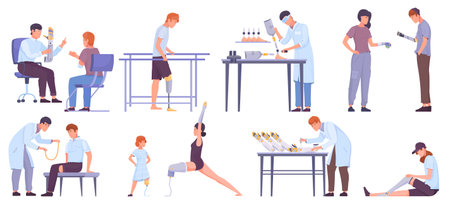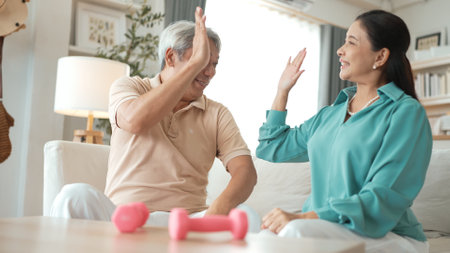Introduction to Home Adaptations for Mobility
Recovering from an injury or illness can be a challenging journey, often requiring changes not only in one’s daily routine but also within the home environment itself. For many individuals across the UK, adapting the home to better support mobility is a crucial step towards regaining independence and improving overall quality of life. Home adaptations can range from minor modifications, such as installing grab rails, to more significant changes like fitting ramps or stairlifts. These adjustments are designed to create a safer, more accessible living space, helping to reduce the risk of further injury and empowering individuals to move around their homes with greater confidence. By investing in thoughtful adaptations, families can support their loved ones’ recovery process while fostering dignity and autonomy at every stage of rehabilitation.
2. Accessible Entrances and Doorways
Ensuring that your home’s entrances and doorways are accessible is a crucial step in promoting mobility and safety after an injury or illness. The goal is to create smooth, hazard-free access for everyone, including those using wheelchairs, walking frames, or crutches. Below, we offer practical guidance on modifications you can make to improve accessibility.
Guidance for Modifying Entrances
Standard entrances often have steps, narrow thresholds, or heavy doors which can pose significant challenges. Consider the following options:
- Step-free Access: Replacing steps with ramps or graded pathways reduces tripping hazards and eases movement for people with limited mobility.
- Level Thresholds: Installing low or flush thresholds helps prevent trips and makes it easier to move mobility aids across doorways.
- Automatic Door Openers: Adding automatic or easy-to-operate handles provides independence for those with reduced strength or dexterity.
Installing Ramps
Ramps are one of the most effective ways to improve access at home. They come in various types and materials to suit your specific needs. When planning a ramp, consider the gradient (ideally 1:12), width, and surface material for safety and comfort.
| Ramp Type | Best For | Main Features |
|---|---|---|
| Permanent Ramp | Main entrances used daily | Durable; built from concrete, metal, or timber; customisable length and width |
| Portable Ramp | Temporary use or travel | Lightweight; foldable; suitable for single steps or kerbs |
| Threshold Ramp | Small internal/external doorsteps | Easily placed over thresholds; compact; non-slip surface |
Widening Doorways for Easier Access
Narrow doorways can be a significant barrier for wheelchair users or those with walking aids. Widening internal and external doorways to at least 800mm (about 32 inches) is recommended under UK accessibility guidelines. This not only improves physical access but also allows carers to assist more easily when needed.
- Pocket Doors: Installing sliding doors can save space and reduce obstacles in tight areas.
- Offset Hinges: These allow doors to swing clear of the frame, increasing usable width without major structural changes.
- Smooth Flooring Transitions: Ensuring that flooring between rooms is level further enhances safe passage.
Your Next Steps
If you’re unsure where to start, seek advice from an occupational therapist or local authority housing team. They can recommend appropriate adaptations tailored to your needs and may even help arrange funding through Disabled Facilities Grants in the UK.

3. Adapting Bathrooms for Safety and Independence
After an injury or illness, the bathroom can pose significant challenges, especially when it comes to maintaining both safety and independence. Making practical adaptations in this space is crucial for reducing the risk of slips, trips, and falls—common hazards for those with limited mobility. Here are some effective strategies to consider:
Walk-In Showers for Accessible Bathing
Traditional bathtubs and shower cubicles with high thresholds can be difficult to navigate if you have reduced mobility. Installing a walk-in shower with level access eliminates these barriers, making it much easier to enter and exit safely. Many walk-in showers also feature built-in seating options and handheld showerheads, offering added comfort and control while washing.
Grab Rails: Extra Support Where You Need It Most
Fitting sturdy grab rails near the toilet, shower, and bath provides essential support during transfers and movement. Grab rails come in a variety of styles to suit your bathroom décor and can be installed at specific heights and angles that best match your needs. These simple additions significantly enhance stability, helping you maintain balance as you move around.
Non-Slip Flooring: A Must-Have for Bathroom Safety
The bathroom floor is often wet and slippery, increasing the risk of falls. Replacing standard tiles with non-slip flooring materials adds an important layer of protection. Options such as textured vinyl or specialised slip-resistant tiles are designed specifically to improve traction underfoot—even when wet—making your bathroom a much safer environment.
Together, these adaptations empower individuals to use their bathrooms with greater confidence and independence, ensuring daily routines remain manageable and dignified throughout recovery or long-term mobility changes.
4. Creating an Accessible Kitchen
Adapting your kitchen after an injury or illness is essential for promoting both safety and independence. The kitchen is often the heart of the home, but it can present significant challenges for those with reduced mobility. By incorporating thoughtful modifications, daily tasks such as preparing meals and cleaning up can become safer and more manageable.
Key Kitchen Adaptations to Consider
| Adaptation | Benefit |
|---|---|
| Lowered Worktops | Makes food preparation and cooking accessible for wheelchair users or those who struggle to stand for long periods. |
| Accessible Appliances | Ovens with side-opening doors, hobs with front-mounted controls, and fridge/freezers at reachable heights reduce strain and risk of injury. |
| Lever-Style Taps | Easier to operate than traditional twist taps, especially for individuals with limited grip strength or dexterity. |
| Pull-Out Shelving & Drawers | Minimises the need to reach or bend, making storage areas far more usable. |
| Non-Slip Flooring | Reduces the risk of slips and falls during meal preparation or cleaning up spills. |
Promoting Independence in Meal Preparation
The right adaptations enable individuals to continue cooking and preparing meals with confidence. For example, lever-style taps allow effortless control of water flow, while lower worktops ensure that utensils and ingredients are within easy reach whether seated or standing. Accessible appliances further support independent living by reducing physical effort required to use everyday kitchen equipment.
Practical Tips for an Inclusive Kitchen Environment
- Plan your layout: Arrange appliances and storage so essentials are within arm’s reach.
- Choose open shelving: This can make it easier to see and access frequently used items.
- Add task lighting: Good lighting over work areas helps prevent accidents during food preparation.
- Consider seated workstations: Designate an area where you can sit comfortably while chopping vegetables or mixing ingredients.
A Collaborative Approach
If you’re unsure about which adaptations will be most beneficial, consult with an occupational therapist or home adaptation specialist. Their expertise ensures that adjustments align with your specific needs, supporting a safe and inclusive environment in one of the most important rooms of your home.
5. Improving Mobility Within Living Spaces
Enhancing mobility at home following an injury or illness often begins with thoughtful adjustments to your living environment. Simple yet effective changes can create safer, more accessible spaces for everyone. Below are expert recommendations to help you move around your home with greater ease and confidence.
Arranging Furniture for Accessibility
Start by rethinking the placement of your furniture. Ensure that pathways between rooms and essential areas, such as the kitchen, bathroom, and bedroom, are wide enough to accommodate walking aids or wheelchairs if needed. Aim for clear walkways of at least 90 cm (about three feet) wherever possible. Place frequently used items within easy reach and avoid overcrowding rooms with unnecessary furniture.
Removing Tripping Hazards
Falls are a leading cause of injury in the home, especially after surgery or illness. Minimise risks by removing loose rugs or using non-slip mats where necessary. Secure electrical cords along walls and avoid leaving shoes, bags, or other objects in walkways. For added safety, ensure good lighting in all corridors and consider installing motion-activated lights for nighttime navigation.
Utilising Mobility Aids
Mobility aids can make a significant difference in maintaining independence at home. Depending on your needs, this may include walking sticks, frames, rollators, or even grab rails strategically placed near steps or in bathrooms. Occupational therapists can provide valuable advice on choosing suitable aids and their correct placement within your living spaces.
Personalising Your Home for Better Mobility
Remember that each individual’s requirements will differ based on their condition and recovery goals. It’s important to regularly review your living arrangements and adapt them as your mobility improves or changes over time. Involving healthcare professionals can help ensure that these adaptations are tailored to your unique needs, promoting both safety and comfort throughout your recovery journey.
6. Smart Home Technology for Enhanced Mobility
In recent years, smart home technology has become a vital component in supporting individuals with reduced mobility following an injury or illness. These innovative solutions are not only about convenience but also about fostering independence and safety at home. Voice-activated systems, such as Amazon Alexa or Google Assistant, enable users to control various aspects of their environment without needing to physically move. For example, someone recovering from surgery or managing a chronic condition can use simple voice commands to adjust the heating, turn on the television, or even make phone calls.
Automated lighting is another key adaptation that greatly benefits those with limited mobility. Motion-sensor lights or systems programmed to specific schedules can help illuminate pathways at night, reducing the risk of falls and making navigation around the home much safer. Smart plugs and switches further allow users to control appliances remotely via smartphones or tablets, minimising unnecessary movement and promoting peace of mind.
Integrating these technologies into everyday life not only enhances accessibility but also boosts confidence for individuals aiming to regain their independence after an injury or illness. By harnessing the power of smart home solutions, families and carers can create a supportive environment tailored to specific mobility needs—making day-to-day living more manageable and comfortable for everyone involved.
7. Seeking Professional Guidance and Funding Support
Adapting your home to enhance mobility following an injury or illness can feel overwhelming, but you don’t have to navigate the process alone. The UK offers a wealth of professional resources and funding options to help ensure your adaptations are both effective and affordable.
Working with Occupational Therapists
An occupational therapist (OT) is often the first port of call when considering home adaptations. These professionals are skilled in assessing your individual needs and recommending practical solutions tailored to your daily routines. An OT can visit your home, identify potential hazards, and suggest specific changes—such as grab rails, ramps, or stairlifts—to improve your safety and independence.
Getting an OT Assessment
You can request a free OT assessment through your local council’s adult social care department. Referrals can be made by your GP, hospital staff, or even directly by yourself or a family member. This assessment forms the foundation for any recommendations and is often required to access further support or funding.
Engaging with Local Councils
Your local council plays a key role in supporting home adaptations. They can provide guidance on what changes are necessary and how best to implement them. Many councils also offer lists of approved contractors who specialise in accessible modifications, ensuring that all works meet safety standards and regulations.
Accessing Grants and Benefits
Home adaptations can be costly, but several grants and benefits are available to ease the financial burden:
Disabled Facilities Grant (DFG)
This government grant helps cover the cost of essential adaptations—like widening doors, installing ramps, or fitting accessible showers. The DFG is means-tested in England, Wales, and Northern Ireland, but not in Scotland, where similar support is available through other schemes.
Other Financial Support
You may also qualify for additional benefits such as Attendance Allowance, Personal Independence Payment (PIP), or Carer’s Allowance. Charities like Age UK or Foundations can offer advice about eligibility and application processes.
Summary Advice
If you’re unsure where to begin, start by speaking with your GP or contacting your local council’s adult social care team. Early engagement with professionals ensures that your home adaptations are safe, suitable, and financially supported—giving you confidence to live independently after injury or illness.


